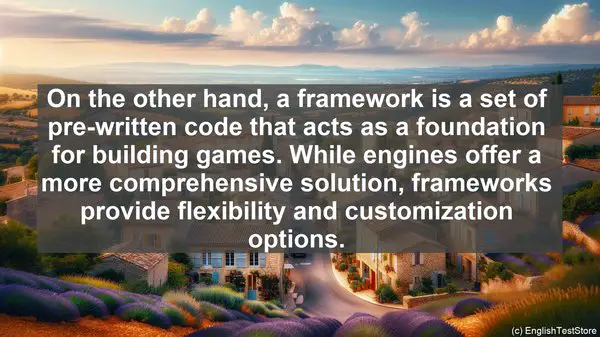Introduction: The Power of Words in Game Development
Welcome to another insightful lesson on game development. Today, we’re going to dive into the world of words. While coding and designing are vital aspects of game development, effective communication is equally important. The right words can convey ideas, solve problems, and foster collaboration. However, in this vast domain, there are several words that often lead to confusion. So, let’s get started with our list!
1. Engine vs. Framework
Engine and framework are two terms that are often used interchangeably, but they have distinct meanings. An engine is a complete package that provides various tools, libraries, and functionalities for game development. On the other hand, a framework is a set of pre-written code that acts as a foundation for building games. While engines offer a more comprehensive solution, frameworks provide flexibility and customization options. Understanding the difference between the two is crucial when choosing the right tool for your project.

2. Bug vs. Glitch
When it comes to issues in a game, the terms ‘bug’ and ‘glitch’ are frequently used. While they both refer to problems, there’s a subtle difference. A bug is a coding error that leads to unexpected behavior or crashes. It’s usually caused by a mistake in the code. On the other hand, a glitch is a temporary and often visual anomaly that occurs during gameplay. Glitches can be caused by various factors, including hardware limitations or data corruption. So, the next time you encounter an issue, you’ll know whether it’s a bug or a glitch.
3. Level Design vs. Game Design
Level design and game design are integral parts of the game development process, but they involve different aspects. Game design focuses on the overall concept, mechanics, and objectives of the game. It’s about creating a cohesive and engaging experience for the players. On the other hand, level design is more specific. It involves designing individual levels, including the layout, challenges, and pacing. While both are essential, mastering each requires a different skill set.
4. Asset vs. Resource
In game development, the terms ‘asset’ and ‘resource’ are often used when referring to files or elements used in a game. An asset is a broader term that encompasses various types of files, including 3D models, textures, audio clips, and more. It refers to anything that adds value to the game. On the other hand, a resource is a specific type of asset that’s used during runtime, such as textures or sound files. Understanding the distinction is crucial when managing and organizing your game’s files.
5. FPS vs. Frame Time
When it comes to game performance, two important metrics are FPS (Frames Per Second) and frame time. FPS refers to the number of frames rendered per second, and it’s often used as a measure of smoothness. On the other hand, frame time is the time taken to render a single frame. While a high FPS is desirable, it’s essential to monitor frame time as well. A consistent frame time ensures a smooth and responsive gameplay experience. So, when optimizing your game’s performance, consider both these metrics.
6. Alpha vs. Beta
Alpha and beta are two stages in the game development lifecycle. The alpha stage is the early phase where the game is still in development. It’s often characterized by limited features, frequent changes, and potential issues. Beta, on the other hand, is a more advanced stage. The game is closer to completion, and it’s released to a wider audience for testing and feedback. Understanding these stages is crucial when setting expectations and planning for your game’s release.
7. DLC vs. Expansion Pack
DLC (Downloadable Content) and expansion packs are additional content released for a game. While they serve a similar purpose, there’s a difference in scope. DLC refers to smaller, often standalone additions, such as new characters, items, or levels. Expansion packs, on the other hand, are more substantial. They offer a significant amount of new content, including new storylines, areas, and features. So, when planning additional content for your game, consider the scale and scope you want to achieve.
8. Multiplayer vs. MMO
Multiplayer and MMO (Massively Multiplayer Online) are two types of games that involve multiple players. However, there’s a difference in scale. Multiplayer games typically involve a smaller number of players, often in the range of 2 to 32. They can be played locally or online. MMOs, on the other hand, are designed for a massive number of players, often in the thousands or more. They create a persistent online world where players can interact and collaborate. Understanding this distinction is crucial when designing the multiplayer aspect of your game.
9. Mod vs. Plugin
Mods and plugins are additional pieces of software that enhance a game’s functionality. While they serve a similar purpose, there’s a difference in how they’re implemented. A mod (short for modification) involves altering the game’s existing files to introduce new features or content. It often requires more in-depth knowledge and can have compatibility issues. On the other hand, a plugin is a separate piece of software that works alongside the game. It’s usually easier to install and doesn’t require modifying the game’s files. So, when considering extending your game’s functionality, choose the right approach based on your requirements.
10. Playtesting vs. QA Testing
Testing is a crucial phase in game development, but there are different types of testing. Playtesting involves having people play the game and provide feedback from a player’s perspective. It focuses on the overall experience, including gameplay, controls, and difficulty. On the other hand, QA (Quality Assurance) testing is more technical. It involves systematically testing various aspects of the game, including functionality, performance, and compatibility. Both types of testing are essential for a polished and bug-free game.

